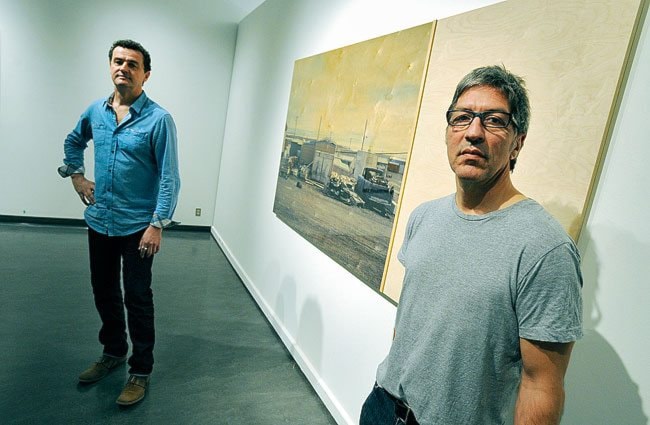It would be hard to end up in Resolute Bay, Nunavut, by accident.
The community of barely 200 residents is the second most northern settlement in Canada.
Montreal-based artists Jacky Georges Lafargue and Louis Couturier picked Resolute as a destination precisely for its isolation.
“I think, not only if you are Canadian, but if you are Canadian there’s one day you want to go up north and do work,” said Couturier.
The multimedia exhibit, based on the time they spent there, opened this week at the Yukon Arts Centre.
The people of Resolute didn’t end up there by accident, either. In 1953 Inuit people were moved from Inukjuak in northern Quebec and Pond Inlet in what is now Nunavut and forced to settle in the desolate High Arctic.
The relocation was part of a federal government plan to establish Canadian sovereignty in the Arctic.
The families were promised bountiful hunting, and that they could be moved back after a couple of years if they didn’t like it. Instead, they were dropped with few supplies into a barren landscape of long winters and endless night. No one was allowed to return home, at least not for many years.
Those who came from Inukjuak would have been closer to home if they had been moved to Toronto.
Lafargue and Couturier did not know what kind of art would come out of their trip north. They believe that art should be created in collaboration with communities, said Couturier.
During their first trip in the summer of 2004, they took photographs and video of people and landscapes, and listened to their stories.
That trip resulted in a video piece featuring Resolute residents talking about their lives.
The story of the relocation came into it because people wanted to talk about it, not because the artists wanted to hear it, said Couturier.
They returned to the Resolute in 2006 to show their video to the people who helped make it.
With help of residents, they built a huge projector screen out of snow and displayed the video on a loop right in the middle of town. It was wintertime - the time of continuous night.
They filmed that journey as well, and those images were edited together into a second film, called Journey of a Day into the Night.
At the Yukon Arts Centre, the artists have set up installations of both films.
They are being projected from inside retired snowmobiles, retrofitted for the purpose. The speakers project towards where the snowmobile driver would sit.
The public is invited to watch the films while sitting on the snowmobile, if they choose.
In the main room of the exhibition, large images from around town are on display.
The artists had their photographs printed by inkjet onto sheets of plywood, which were then sealed with an epoxy resin.
The grain of the plywood shows through the image, and the resin adds a metallic glimmer. Although the images are flat, they appear to warp and distort as light reflects off their surface.
Plywood is both the canvas and a feature of the photographs themselves.
The first shacks of Resolute Bay were made from scrap wood, and even today just about everything in the town is cobbled from plywood.
The Yukon Arts Centre helped to fund a souvenir book documenting the artists’ journeys and the exhibitions they have mounted around the world as part of the project.
This Yukon exhibition could be the last for the work, said Couturier.
“We’re happy because we started up north, and we finish up north.”
In the adjacent gallery space, Atlin painter Don Weir is presenting his own homage to the North.
His large oil canvases play with colour, light and shadow, breaking down landscapes into their most basic elements.
After years of diligently recreating expansive panoramic landscapes, he encountered minimalism about 10 years ago at the Metropolitan Museum of Art in New York.
“Once I saw those, I thought painting the North would actually - it might actually capture it better,” said Weir.
“What I have been doing over the past 10 years is shifting the focus from the horizon line down to right in front me, because the beauty of the landscape is right there.”
Several of the paintings in the exhibit, An Ephemeral Light, were inspired by a section of windblown trail only a few feet long between Weir’s house and his studio in Atlin.
“One of the wonderful things about being a painter is your job is to go for walks and just look at stuff.”
A friend of Weir’s described the work as “haikus to light and shadow,” he said. Weir’s evolution hasn’t been a conscious choice, so much as something that happened to him.
“You’re kind of like a kitten in the kitchen that people keep throwing these little balls of foil on the floor for you to play with.”
Though he loves pure abstraction, his work will always be inspired by natural light, said Weir.
“I’m hoping that people take the time to actually, not just look at the paintings as paintings of scenes or something, but actually maybe absorb the feeling of the whole thing.”
Resolute Bay: The Daytime Journey in the Night and An Ephemeral Light will display at the Yukon Arts Centre until May 4. Admission is by donation.
Contact Jacqueline Ronson at
jronson@yukon-news.com
